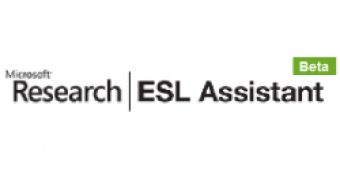Microsoft has unveiled a new Machine Translation tool, courtesy of Microsoft Research, bundled with Live Search as an online service designed to provide writing assistance. The ESL (English as a Second Language) Assistant is nothing more than a prototype at this point in time, and is set up to focus on a limited number of mistakes that typically go by undetected by the existing English language proofing tools. The Assistant essentially hunts for complex and contextual mistakes that are beyond the strictly syntactic and lexical capabilities of the proofing solutions available.
"The ESL Assistant uses statistical models to suggest corrections for a number of common learner error patterns that are not currently supported by the proofing tools in Microsoft Office products. The service also tries to help users judge whether a suggestion truly represents an improvement by showing real-life examples returned by a web search," stated Chris Brockett, Microsoft Research Computational Linguist.
Brockett revealed that the ESL Assistant deploys advanced statistical models in order to address and correct uncharacteristic mistakes. At the same time, the tool is intimately connected to Live Search, and each suggestion is also performed as a search in order to offer the user conclusive examples after the error is corrected. Additionally, Microsoft is intent on offering the tool as an add-in for the Office 2007 System, in an effort to make up for the limitations of the grammar checker.
Still, the main implementation of the ESL Assistant is as a web service. In this regard, users will be able to take advantage of what Brockett referred to as of huge statistical models deployed to pinpoint error sources. The tool also comes with a context-sensitive inline thesaurus feature meant to offer alternative suggestions that take in consideration the entire text available.
"In its present form, the service is unapologetically experimental ('pre-alpha,' despite the beta label). The range of error types that it corrects is still small, it does not capture everything, and it sometimes gets things wrong. Work to improve error detection accuracy and coverage is ongoing; we expect to roll out new modules and updates as the service matures. The present interface certainly does not represent what one would expect to see if this service were some day fully integrated into a shipping product. With the current prototype, we will be gathering data about where the service succeeds and where it does not, to help inform future directions of development," Brockett concluded by saying.

 14 DAY TRIAL //
14 DAY TRIAL //